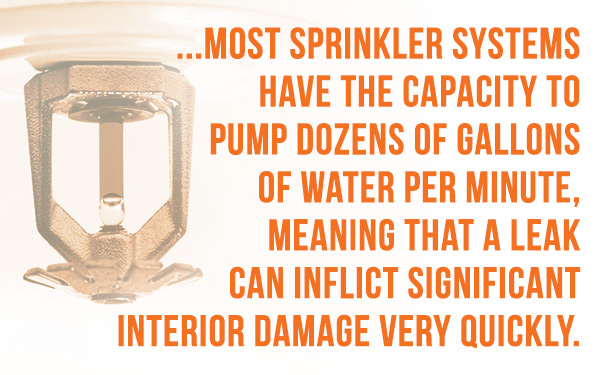How to Protect Your Business from Water Damage
August 16, 2022
Water damage: two words no business owner wants to hear. Many business owners and property managers’ greatest concerns stem from fire damage, but water can be just as catastrophic. While fire losses continue to top the severity charts, water damage has climbed the ranks the past few years in both frequency and severity. Industry experts are reporting that water damage accounts for well over a third of all construction losses. Commercial, non-weather water damage accounts for roughly $16 billion in paid claims annually, and the U.S. Congressional Budget Office estimates an additional $9 billion in commercial losses due to hurricane and storm-related flooding.
Before you start down the path of setting up a water mitigation plan, it’s important to know where these claims are coming from. Liberty Mutual data shows that in non-fire situations, accidental water damage from piping systems and leaking sprinklers account for 36% of losses in multistory buildings. Roof leaks, appliance leaks, and weather-related floods make up the remainder of water claims.
Preventing Water Damage
The best way to mitigate water damage is to prevent it from happening in the first place. Luckily, several steps are available to business owners and property managers, several of which that don’t come with a high cost.
- Ensure attic piping supplying upper floor sprinklers is covered, not wrapped, with adequate insulation to trap rising warmth and prevent freezing. Additionally, schedule regular servicing for attic sprinklers.
- Remove or isolate all unused piping from water sources.
- Dike or seal floor openings in multistory buildings.
- Maintain heat, sprinkler protection, and alarm services for all vacant and unoccupied areas.
- Work with your sprinkler contractor to note remote plumbing and sprinklers in stairways, closets, etc. This will ensure windows, ducts, and other possible sources of cold drafts don’t increase the likelihood of freezing issues.
- Inspect roof drains regularly – monthly or quarterly, as needed.
- Inspect roofs at least annually.

Mitigating Water Damage
Even with these steps in place, water losses can still happen. When they do, many business owners’ mitigation plan is to immediately contact a water cleanup and restoration company. The issue with this approach is that most sprinkler systems have the capacity to pump dozens of gallons of water per minute, meaning that a leak can inflict significant interior damage very quickly. Further, many losses involve leaks in pressurized drinking water or fire water systems, which can often go unnoticed if the leak happens after business hours or over the weekend. Therefore, it is imperative to establish specific mitigation procedures to limit potential future water damage. Effective strategies include:
- Create a map of water shutoff and control valves that is stored in an accessible area, enabling any onsite personnel to take immediate action.
- Train staff on emergency response expectations, especially how to shut down the water system and assist the fire department in coordinating sprinkler shutoff.
- Confirm wet building systems conform with code and quality standards. Upgrading your systems can provide premium relief with certain carriers in some cases.
- Place water monitoring or water flow devices in highly sensitive locations to identify potential unintended water movement. These include sensors for water, temperature and humidity, flow and pressure, and advanced acoustic sensors. Many carriers are offering increased sublimits and reduced deductibles for installed, approved water detection systems, especially when writing builder’s risk coverage.
- Establish a plan for immediate and aggressive drying after water damage, including procedures for salvaging highly susceptible property such as electronics, furniture, rugs, and valuable wallpaper.
- Install leak detection devices with alarms, especially near equipment rooms, bathrooms, storage tanks, water heaters, AC units, and main water service feeds. This would help alert you to a leak before it gets out of hand. Your broker can point you in the direction of quality leak detection products if you need help.
- Review your lease requirement with your broker from both an owner and lessee perspective so the indemnification language is clear on what each party is responsible for (e.g., tenant improvements, personal property, etc.).
If you do find a water loss, we recommend the steps below be followed immediately and in order:
- Shut off all water.
- Initiate your water mitigation plan, e.g., aggressive drying and/or removing valuable material in susceptible areas.
- Call the fire department and predetermined water cleanup/restoration company.
- Take photos and document the damage.
- Report the loss to your insurance broker right away.
Next Steps
Water damage claims may be on the rise, but there are several steps you can take to protect your property from water damage. Even just implementing a few of these safeguards can prevent an occurrence from becoming a major event. Every business is unique and has different needs, so no two water mitigation plans will be the same. Talking to a qualified and licensed insurance broker about the specifics of your risk is a great starting point, as we can review the unique nature of each business and better tailor preventative measures to your property. Reach out to Parker, Smith & Feek’s Real Estate Practice Group if you have questions or would like to get started.
Resources and References
- Using big data to predict non-weather water claims risk, PropertyCasualty360.com.
www.propertycasualty360.com/2020/01/31/using-big-data-to-predict-non-weather-water-claims-risk/ - Construction market hammered by rising fire, water damage claims, Business Insurance Holdings.
www.businessinsurance.com/article/20190604/NEWS06/912328845/Construction-m - Expected Costs of Damage From Hurricane Winds and Storm-Related Flooding, Congressional Budget Office.
www.cbo.gov/publication/55019#:~:text=CBO%20estimates%20that%20under%20current,analyzed%20(see%20figure%20below) - Fire Sprinkler Systems, Fire Sprinkler Services.
www.firesprinklerservices.com/service-areas/new-installations/
The views and opinions expressed within are those of the author(s) and do not necessarily reflect the official policy or position of Parker, Smith & Feek. While every effort has been taken in compiling this information to ensure that its contents are totally accurate, neither the publisher nor the author can accept liability for any inaccuracies or changed circumstances of any information herein or for the consequences of any reliance placed upon it.




